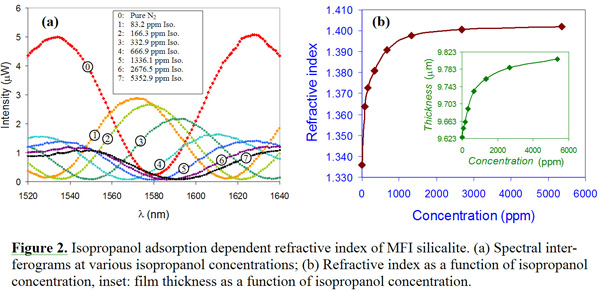
ACS PRF | ACS
All e-Annual Reports

43927-GB5
Investigation of Adsorption-Dependent Optical Refractive Index of Microporous MFI Zeolite Thin Films for the Development of In Situ Chemical Sensors
Introduction: Low-cost optical chemical sensors capable of fast and in situ detection of various organic compounds are highly demanded in petroleum industry. Unfortunately, currently available sensors are insufficient in sensitivity, specificity and stability to measure the large number of organic compounds involved in petroleum production, transportation, storage and post processing. Integration of chemical recognition materials with optical microdevices has become an effective approach for chemical sensor development. Our recent work reveals that nanoporous zeolites process the unique combination of chemical and optical properties that are idea for development of highly sensitive and selective chemical sensors. We successfully developed a new type of chemical sensor by directly synthesizing zeolite thin films on optical fibers, and demonstrated their capability for sensitive detection of various organics in gas and liquid phases. However, further improvement of the sensor performance requires an in-depth understanding of the optical behavior of zeolites upon interaction with various chemicals.
Objective: In this project, we aim to measure the adsorption-dependent optical refractive index of various zeolite thin films for the purposes of chemical sensor development and optimization. The data obtained from this proposed research will enhance our basic understandings of the optical properties of zeolite materials. In addition, the data are fundamentally important to the fields of materials science, photonics, and chemical engineering and useful for theoretical modeling in material chemistry and device physics.
Major Research Results: Dense MFI silicalite thin films were grown on the cleaved endface of a single mode optical fiber by in-situ crystallization in a clear synthesis solution obtained by mixing 30ml H2O, 5.65ml (1M) TPAOH, and 10.2ml TEOS. The thickness of the zeolite layer was ~10mm by scanning electron microscope (SEM) measurement. The zeolite coated fiber was used to study the adsorption-dependent refractive index of the zeolite film. The apparatus for optical experiments is shown schematically in Figure 1. The optical source used in the experiment was a tunable laser made by Agilent (81640A) with the wavelength range of 1510-1640nm.
The spectral interferograms of the silicalite film in contact with isopropanol vapors of different concentrations are shown in Figure 2 (a). The sinusoidal spectral interferograms indicated high quality interference signals generated by the coated silicalite film. The relationship between refractive index and concentration shown in Figure 2 (b) is reminiscent of the type-I isotherm and suggests a deterministic dependence of refractive index on the adsorption level. The refractive index increased quickly at low-level concentrations and tended to saturate at high concentration levels. The inset of Figure 2 (b) shows the thickness of the silicalite film as a function of the concentration. The thickness increased with isopropanol sorption level as a result of the structure expansion upon molecular adsorption. As shown in Figure 3 (a), the resonance spectrum of the integrated sensor shifted towards short wavelength region as a result of increase of isopropanol concentration. Figure 3 (b) plots the resonance wavelength as a function of isopropanol concentration. An increase of isopropanol concentration from 0 to 114ppm produced a resonance wavelength shift of 4nm. Assuming a spectral resolution of 0.001nm of the spectrometer, the estimated detection limit was about 28ppb. Conclusions and Future Work: In the reported period, we successfully characterized the adsorption dependent refractive index of MFI silicalite thin films synthesized on an optical fiber using isopropanol as a model adsorbate. We found that the adsorption induced refractive index change provided a sensitive indication of the analyte concentration presented in the environment. The relationship is also deterministic and can thus be used for chemical sensor development. The characterization results were used to guide the design and fabrication of zeolite coated LPFG chemical sensors. The preliminary evaluation indicated that the sensor had a superior sensitivity for detection of chemical vapors. The continuation of the research will focus on characterization of the adsorption-dependent refractive index using other types of chemicals and systematical testing of the zeolite-LPFG sensors. 
 With the adsorption induced refractive index known, we designed a long period fiber grating (LPFG) to be integrated with the zeolite thin film for highly sensitive chemical detection. A LPFG is an in-line fiber device that can thus be used as a refractometer with very high sensitivity. As shown in Figure 3 (b-insert), the sensor was made by coating a thin layer of zeolite film on a LPFG. Upon adsorbing analyte molecules, the zeolite thin film changes its refractive index, producing a shift of the grating resonance wavelength that can be detected to quantify the amount of the analyte presented in the environment.
With the adsorption induced refractive index known, we designed a long period fiber grating (LPFG) to be integrated with the zeolite thin film for highly sensitive chemical detection. A LPFG is an in-line fiber device that can thus be used as a refractometer with very high sensitivity. As shown in Figure 3 (b-insert), the sensor was made by coating a thin layer of zeolite film on a LPFG. Upon adsorbing analyte molecules, the zeolite thin film changes its refractive index, producing a shift of the grating resonance wavelength that can be detected to quantify the amount of the analyte presented in the environment. 